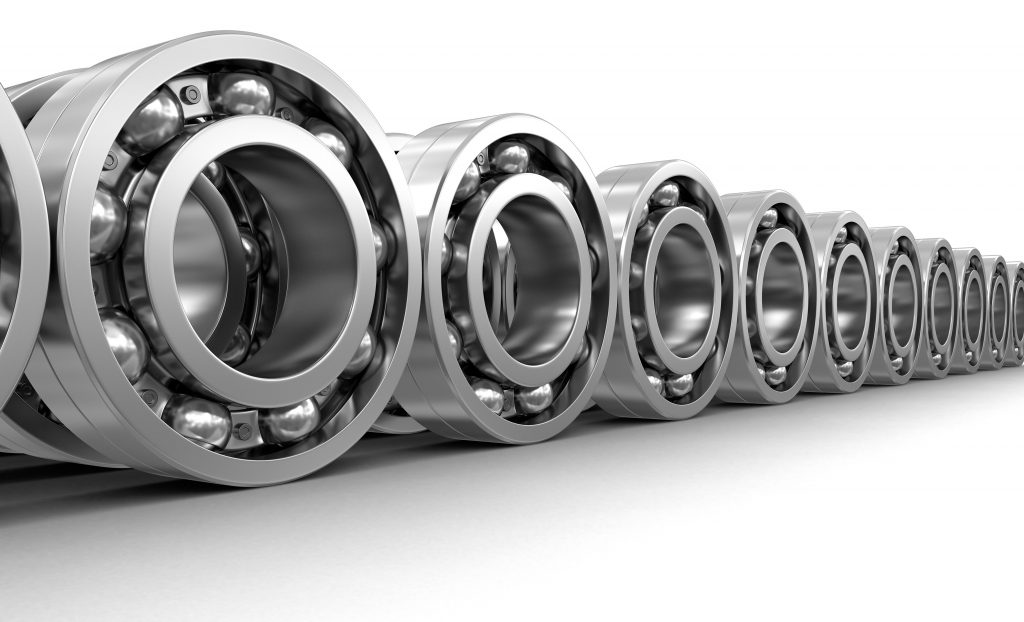
Water and Bearings
The most effective way of preventing damage by water, is preventing water from getting into the bearing.
March 12, 2021 | By Douglas Martin
 Photo: EpicStockMedia - stock.adobe.com
corund - stock.adobe.com
Photo: EpicStockMedia - stock.adobe.com
corund - stock.adobe.com 
Photo: corund – stock.adobe.com
Water affects bearings in two ways. First, by corroding the contact surfaces, which can lead to: surface damage that will create initiation points for fatigue (spalling); surface damage that can create initiation points for ring or roller fracture; and, creation of iron oxide particles that will act as an abrasive medium when rolled over. It should be noted that corrosion generally occurs at standstill when the bearing is not rotating.
Second by lubricant interruption. When water comes between the roller and race surface, it is squeezed out of this interface. Compare this to the behavior of oil. Oil, under pressure, increases in viscosity until it is like a layer of silver (metal between the roller and race preventing contact). Since water cannot support the load applied between the roller and race interface in this manner, it allows metal-to-metal contact leading to abrasive wear and surface-initiated fatigue. This damage occurs when the bearing is rotating.
Therefore, water poses a threat to the bearing both while operating and while stationary.
In turn, what are the solutions?
Sealing and grease
The most effective way of preventing damage by water, is preventing water from getting into the bearing. The least costly of the solutions, is often already at hand, but poor practices don’t protect the bearing as it should be protected.
To accomplish protection from water, one needs effective sealing and greasing. Note the term greasing is used, as opposed to lubrication. Since grease serves two purposes (lubrication and sealing), in a wet environment, sealing is the more important role that grease plays.
An effective seal is one designed for the application. It should prevent both the ingress of water and allow drainage of water from the seal, should any be able to penetrate the barrier. Some sealing solutions are designed thinking only of preventing water ingress without the allowance from draining or purging with grease.
Stainless Steel
“Common bearing” stainless steel is a compromise in two ways, first, it is a poor bearing material, and second, it is truly stain “less”, so it still will corrode but less than standard bearing steel. Although a few different grades are used for industrial applications, none are a good bearing materials or fully corrosion resistant.
For a stainless steel, as hardness increases, corrosion resistance decreases, therefore, there must be a compromise between a material that resists corrosion, and a material that can carry a load.
The downside to “industrial grade” stainless steel is the loss of bearing capacity. In the book, STLE Life Factors for Rolling Bearings, Erwin Zaretsky, tabulates the “life factor” for bearings of standard bearing steel (52100) as three and the “life factor” for stainless steel used for bearings (440C) as 0.6, suggesting that the predicted life of stainless steel is five times lower than standard bearing steel.
It is true that several “premium” grades of stainless steel exist, and are used in aerospace and racing applications. However, they do not appear in general industrial applications, typically because the cost to produce the material makes the cost of the bearing too expensive for the benefits. In fact, some of this stainless steel will outperform regular bearing steel, but it is at a price that can only be afforded by aerospace and Formula 1 race cars.
The most effective way of preventing damage by water, is preventing water from getting into the bearing.
Also, stainless steel only combats corrosion, it does not combat poor lubrication conditions. Therefore, you may make a bearing corrosion resistant, but you still have not addressed the lubrication issues.
Coatings
The generally accepted coatings used for industrial bearings rolling surfaces are zinc alloy coatings. The benefit of such coatings is they are applied to standard bearing steel, so there is not a loss in bearing capacity. As well, zinc surface coatings are a “tribological thin coating,” which means it improves the performance under poor lubricating conditions. As such, coatings can address both the corrosion issue and the lubricant interruption issue.
Availability
The availability of a corrosion resistant product in the industrial market is a function of the overall use in industry. Meaning, that bearing companies do not make all their bearings in the choice of regular steel, stainless steel or coated steel. Rather, the sizes are limited, for instance, if you wanted a stainless-steel deep groove ball bearing, the maximum size would be for a 50 millimetre shaft. In terms of unit block ball bearings, the shaft size goes up to about one and 15/16”.
There are specific bearing sizes related to an application that are produced regularly. For instance, in the oil and gas industry in Western Canada, some compressors use bearings with high nitrogen stainless steel, with success. These bearings, both angular contact ball bearing and cylindrical roller bearings are made in the specific common sizes used in a handful of compressors. The cost of a bearing set is about 10x the cost of a bearing using standard materials. However, in the application, they pay for themselves with the elimination of production losses, as a result of bearing failures from the corrosive environment of sour gas.
This comes back to the point about the best way to address a water issue. Prevent it from getting into the bearing in the first place, and it will save money in terms of poor machine performance, or the expense of a bearing that can tolerate the conditions. MRO
____________
Douglas Martin is a heavy-duty machinery engineer based in Vancouver. He specializes in the design of rotating equipment, failure analysis, and lubrication. Reach him by email at mro.whats.up.doug@gmail.com.
